Identity
Laminaria japonica Areschoug, 1851 [Laminariaceae]
FAO Names: En - Japanese kelp, Fr - Laminaire du Japon, Es - Laminaria del Japón
Biological features
Thallus consisting of root-like holdfast, short stipe and blade. Blade long-belt shaped, up to one meter long, 10-20 cm broad, with margin undulate and overlapping, thick at the middle and thin at the margin. A short and small stipe and holdfast at the base of the blade. Holdfast sturdy (presenting haptera) with which the algae is fixed to rocky substratum. Colour: thick dark green; blade surface brown, occasionally glaucescent.
View SIDP Species fact sheet
Images gallery
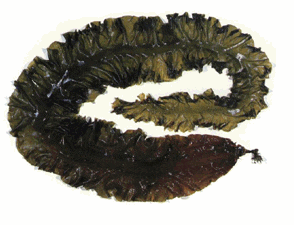
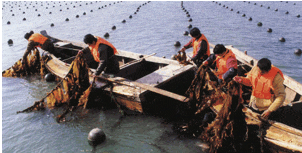
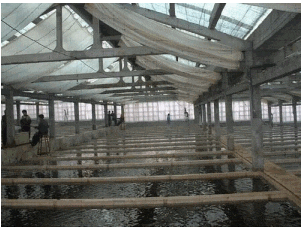
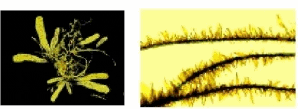

Profile
Historical background
Shinran-shonin, a famous old Buddhist priest, is said to have been the first to propagate Laminaria in 1718 in Japan. Currently, the cultivation of Japanese kelp is a well-developed practice, particularly in the western Pacific, and involves China, Japan, the Republic of Korea and the Democratic People's Republic of Korea. China is by far the largest producer, but Japanese kelp is not indigenous there. It spread to Chinese coasts from Japan in 1927, first becoming established on sublittoral rocks at Dalian on the northern coast of the Yellow Sea in Liaoning Province. Cold water reefs at Dalian provided ideal growing conditions. In the 1940s, Japanese experts associated with Chinese experts began kelp farming experiments in Shandong Province. Large-scale kelp farming was not established until the early 1950s, when the three key problems that hindered it before were resolved: 1) fertilising the sea, greatly expanding the farming area; 2) breeding summer instead of autumn seedlings, prolonging the growth period; and 3) the southward introduction of commercial cultivation beyond its natural distribution on the China coast to Liaoning, Shandong, Jiangsu, Zhejiang, and Fujian provinces.
In addition to the countries mentioned above, Russia is a recent producer in its Far Eastern region. L. japonica is a major commercially important species in this area, ranking among the top culture organisms. Japanese kelp is being cultivated in the Primorsky Territory on three industrial kelp farms with an area of about 400 ha. At present, the average crop capacity is 26 tonnes wet kelp/ha. The estimated Russian production is about 10 000 tonnes/yr.
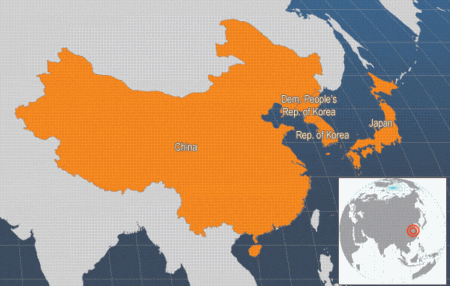
Habitat and biology
Japanese kelp grows in temperate cold water zones. Its developed holdfast firmly attaches to rock or other solid substrates in the sublittoral zone. Its deepest distribution is about 10 m, or more, depending on turbidity of seawater. In the Asian-Pacific region, the species is native to the northwest coasts of the Pacific ocean. It is found along the northern coastline of the Sea of Japan from northern Hokkaido Island and coastal regions near the Kinkazan Mountains of Honshu Island, across the Kuril Island chain to Yamchatka Peninsula in Russia, along the northern coastline of the Okhotsk Sea, south to Sakhalin Island and south-east as far as the Tartar Channel near Wonsan in the Korean Peninsula. Laminaria exhibits generation alternation, i.e. the sporophyte generation alternates with the gametophyte generation. The diploid (2n) sporophyte plant is a large multicellular macroalgae, whereas the haploid (1n) microscopic female and male gametophytes have one or a few cells. Thus, Laminaria exhibits heterothallism.
As mentioned earlier, Japanese kelp is a temperate cold water species; thus, when seawater temperatures reach >23 °C, most of its blade will rot and only the base part is retained for over-summering. When the seawater temperature decreases to 23 °C or below the base part of the blade resumes growth until the autumn and forms sporangia; after releasing zoospores, the old blade will die. Thus, the natural life span of Japanese kelp is 2 years across two winters; however, in aquaculture conditions, kelp is only reared through one winter.
Production
Production cycle
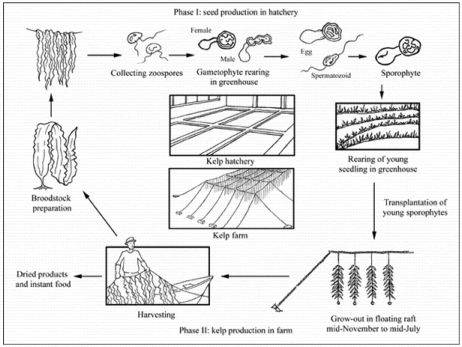
Production systems
Seed supply
Seedling production is the key to the kelp rearing system.
Seedling production facilities can produce 800 million seedlings annually. After collecting the zoospores, the substrates with the attached spores are arranged in the greenhouse (hatchery). Because the gametophytes are autophytes, the breeding regime involves:
- Light intensity control and light periodicity adjustment by means of black and white roof-curtains.
- Seawater temperature control, adjusted by coolers.
- Fertilisation with chemicals, normally nitrate and phosphate.
- Removal of miscellaneous algae.
- Strengthening the settling capacity of sporelings (young sporophytes).
- Controlling sporeling growth rate by temperature control.
All of this routine management is practiced in greenhouses from July to the end of October. When the seawater temperature in the farming site declines to 20 °C, the young seedlings, attached to substrates will be moved to nursing sites for further rearing into large seedlings for transplantation.
The rope length of each sporeling-curtain/substrate is about 50 m; there are about 8-10 seedlings per cm of rope. Hence, each sporeling-curtain has approximately 40 000-50 000 seedlings. Farmers estimate the quantity of the seedlings by the length of rope of each sporeling-curtain. The sporelings are reared in the nursing site until they reach 10-15 cm, when they are transplanted onto culture ropes. Farmers buy seedlings from seedling rearing stations/companies and nurse them to the size for transplantation.
Ongrowing techniques
Generally, when the total-N level is less than 100 mg/m³, the sea is fertilised, for example by spraying ammonium nitrate.
Ongrowing techniques are similar in each of the countries that produce Japanese kelp. There are three methods, as described below.
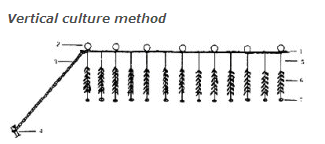
The vertical culture makes good use of water space and is a simple, easily managed procedure. Spacing between the kelp ropes allows currents to pass through them, thus stimulating sporophyte growth. As the plants hang downwards on the kelp ropes they shade each other from excess exposure to sunlight. However, because illumination decreases with water depth, the plants at the lower ends of the ropes may not get enough light to meet their requirements for good growth. This is a disadvantage of this system.
The horizontal culture method can be used in shallow sea areas where turbidity is high. In these, which are typical of conditions found along the coastlines of southern China, horizontally positioned culture ropes give greater and more evenly distributed illumination to all of the attached plants than the hanging kelp rope raft culture method. In inshore areas with slower currents, the use of this method allows the spreading of the plants more evenly in the water, so that light intensity and nutrient exchange are optimised. The disadvantage of this model is that when floating raft lines are positioned at cross-currents, plants suspended from horizontal ropes have a tendency to twist, intertwine and bunch together. This usually happens during stormy weather, when current forces are stronger.

The mixed culture method combines vertical and horizontal systems. The ropes are first suspended vertically and then lifted into a horizontal position. The mixed method has now been widely adopted by Laminaria seafarming enterprises in China. The mixed vertical-horizontal method overcomes the disadvantages encountered when using either of the other systems. All plants receive well-balanced light, and thus variations in growth and weight are reduced. Furthermore, the vertical-horizontal method is less labour-intensive than the hanging kelp rope raft method because it does not require periodic reversals of the kelp ropes. In this system, adjustments of the connecting ropes usually need to be done only once a month.
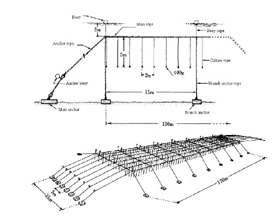
The figure above shows a culture system that is used in Japan and is suitable for sites where the turbidity is lower. In order to prevent stronger illumination scorching the kelp plants, the main ropes are installed 2 m beneath the water surface. This method differs from the systems used in China in a number of details, including the location of the buoys, the number of main ropes, and the presence of a branch anchor.
Harvesting techniques
Harvesting is a labour intensive procedure carried out that involves the following manual operations: untying the culture rope from the floating rafts; loading the kelp into sampans (boats); and transporting them to the seashore for sun-drying or processing.
The harvesting season depends on the seawater temperature and the demand from processing units. When the seawater temperature reaches 21 °C, the kelp must be harvested; otherwise, it will rot, due to poor-tolerance to higher temperatures.
Handling and processing
There are two main processing methods: immediate sun-drying or salting, followed by sun-drying.
Currently, fresh kelp harvested during April is first boiled in seawater and then cooled in cold seawater. Then it is stored in cool storage for processing into seasoned instant food.
Most farmed kelp is harvested during June to July, and sun-dried or salted. The salted kelp is destined as an edible marine vegetable food that is consumed in inland areas; however, most of the ordinary sun-dried kelp is a raw material for the production of iodine, mannitol, and alginates. China is the largest producer of these chemicals from farmed kelp in the world. The advantage of using farmed kelp is that the supply is stable and the quality controlled.
Production costs
The cost of seedlings is currently about USD 0.50-0.60 per seedling-curtain (each with about 40 000 to 50 000 seedlings). No data on total production costs available.
Diseases and control measures
| DISEASE | AGENT | TYPE | SYNDROME | MEASURES |
|---|---|---|---|---|
| Malformation diseases | Macrococcus spp. (and other anaerobic sulphate-reducing saprophytic bacteria; also tannin poisoning, due to improper treatment of palm rope substrate materials) | Bacteria | Gametophyte metamorphosis disease: very slow gametophyte growth; cell wall thickening; chloroplast degeneration with pigment change to a yellowish colour; vacuolar contraction with cell protoplasm shrinkage; in serious cases, lipophanerosis occurs (chloroplasts & protoplasm form transparent or dark droplets in cell centre) Egg death: egg shrinks inside oogonium & is unable to extrude & attach to lip of oogonium in preparation for fertilisation; as disease advances, egg further contracts & gradually dies; some eggs may extrude but, because of pronounced loss of vigour, fail to attach & drop off from the apical lip of the oogonium Rot & malformation of young sporelings: one or a group of cells expand abnormally to 3-6 times larger than normal; enlarged cells divide abnormally, leading to very disordered cell arrangement & deformed sporelings; grape-like malformed sporelings may be composed of several to a hundred cells; deformation is irreversible; infected sporelings unable to recover to normal shape & gradually die |
Avoid use of diseased & over-mature parent Laminaria; collect parents before temperature rises above 21ºC; avoid parent damage & improve transport & handling procedures; sterilise indoor water circulation system with bleaching powder before spore collection proceeds; separate mature sporophyte cultivation system from sporeling cultivation system; remove rotted spots on parent blades used for spore collection purposes; clean all sporeling substrates & culture tanks; change all seawater in indoor water system; reverse flush filtration tanks; lower circulating water temperature <10 °C; reduce stocking density |
| Sporeling detachment disease | Pseudomonas spp. (& excessive illumination) | Bacteria | Sporelings detach from culture ropes; stipes become soft & faded in colour; holdfasts become hard, brittle & weakened; abnormal growth of holdfast rhizoids from sides of stipe; stipe & blade tips rot | Reduce excessive illumination; treat with antibiotics in rearing tanks |
| Twisted frond disease | Not yet determined | Mycoplasma-like organisms | Coarsened, swollen & hollowed stipes; twisted or spiral-shaped fronds; withered or shortened holdfasts; frond surface rough or coarse; plants develop thick holdfasts with little branching; some stipes divide into two parts joining the blade to the holdfast; other stipes may appear unaffected | Remove all infected plants from culture ropes at raft site; improve ecological conditions, including reducing intensity of culture |
| Green rot disease | Poor illumination | Environmental | Apical part of fronds turn greenish & become soft; symptoms gradually spread to lower part of fronds; serious spread of disease eventually results in decay & death of entire plant | Raise culture ropes; periodically reverse culture ropes |
| White rot disease | Excessive illumination & insufficient nutrients | Environmental | Blades fade from brown to yellowish & finally to white; disease spreads from apical part to lower part; eventually whole frond decays & falls from the culture rope | Apply nitrogen-based fertilisers over seafarming area; lower culture ropes to decrease illumination |
| Blister disease | Freshwater dilution of seawater after heavy rainfall; especially prevalent in shallow bays | Environmental | Blisters form on fronds, followed by decay | Lower culture ropes below the mass of freshwater run-off (which tends to be near surface) |
| Twisted blade disease | Excessive illumination | Environmental | Reduce light intensity by adjusting height of culture ropes | Lower culture ropes below the mass of freshwater run-off (which tends to be near surface) |
| Red tide sporeling disease | Pollution/red tides | Thought to be environmental but unidentified pathogen my be implicated | Chloroplast pigmentation fades; cell plasma shrinks; cellular arrangement in tissues disordered; sporelings turn greenish yellow & quickly die | Spray-clean sporeling mats immediately; completely change seawater supply & reverse-flush filtration tanks |
Although problems associated with environment stress can be controlled as indicated in the table above, practical experience indicates that good site selection is the most important factor. Most farms that are properly sited do not suffer any environmental diseases. Diseases caused by pathogens happen sporadically in some years and in some farms. There are no epidemiological reports on disasters in kelp farms.
Statistics
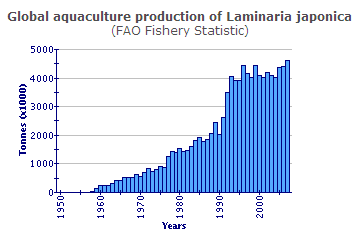
According to FAO data, China was responsible for 89 per cent of global farmed Japanese kelp in 2002. The next largest producer was DPR Korea (9.4 per cent). Over the decade 1993-2002, global production peaked in 1999 ( 4 917 788 tonnes). Current production in DPR Korea in 2002 was less than half that estimated in 1993.
Market and trade
Since 1958, the breakthrough in rearing techniques for the production of summer seedlings has led the aquaculture sector to develop quickly. For example, China produced 22.3 tonnes of Japanese kelp in 1952 but by 1958 it had jumped to 6253 tonnes (dry weight). The success was attributed to the availability of summer seedling supply. During the 1960s to 1980s, the development of the algin production sector further pushed kelp farming into a higher level. By 2000 Chinese production had reached over 4 million tonnes/yr (wet weight). At present, about 50 per cent of the dried kelp in China is used for processing into algin, mannitol, and iodine; the rest is mostly destined for the domestic market, but a small amount of processed kelp is exported to Japan and Taiwan Province of China as a marine vegetable.
In Japan, the emphasis has been on increasing the production of Laminaria which grow naturally, as this is sufficient to satisfy domestic consumer demand. There are some obstacles that inhibit a Laminaria cultivation in Japan, especially the fact that the plant takes 2 years to grow into a desirable market product for Japanese consumers.
DPR Korea is the second largest producer in the world. There, farmed kelp is ground into powder for nutrient supplements. Apart from China, Japan, DPR Korea, RO Korea, and Russia are net consumers of Japanese kelp. Even if they do export, the quantity is small, and no official statistics about it are available.
Status and trends
Japanese kelp is a traditional marine vegetable in the Orient, particularly in China, Japan and Korea; it is also an important raw material for processing algin, mannitol, and iodine. It is the best bio-concentrator of iodine from seawater in the biological kingdom. During an eight months life span, Japanese kelp can concentrate iodine high as 100 000 times the level in seawater. Hence, kelp is considered one of the best renewable sources and kelp farming in these countries has been considered an indispensable part of the aquaculture sector. Due to its labour intensive nature, outputs from Japan and Republic of Korea are not expected to expand in the near future. The production of kelp in DPR Korea is suffering from worn-out facilities for seed production that cannot meet the demands of further development. Production in China is expected to remain at current levels because there is no evidence of any dramatic increase in the domestic market in the next decade.
Main issues
No specific issues recorded.
Responsible aquaculture practices
Since kelp is an autophyte, its farming is an environmentally friendly activity, unlike some other aquaculture activities, especially finfish farming that has resulted in environmental deterioration. All kelp farming countries have realised that it can help to maintain a healthy coastal seawater environment, particularly when kelp are reared in polyculture with other species, such as finfish, oysters, scallops, etc. There are no records of red tides occurring in kelp farming sites.
There are about 400 million people living in Chinese areas deficient in iodine. Kelp is one of the excellent sources of iodine, which explains why it has been considered a priority sector since the 1950s. The production of kelp is rather stable, as it continues to be the major source for iodine supplementation. However, another processed product from kelp (algin/alginate) that is exported suffers from the vagaries of fluctuating international markets.
Concerns exist about the possible accumulation of heavy metals from polluted seawater in edible kelp. Fortunately, no cases of heavy metal pollution have been reported, due to most kelp farms being far distant from industrial zones.
March 2010



